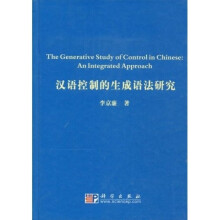序
Acknowledgements
Abstract
摘要
Abbreviations
Chapter 1 Introduction
1.1 Control Theory: An Overview
1.1.1 Definitions of Control
1.1.2 Chomskys Typology of Empty Categories
1.1.3 Basic Questions Concerning Control
1.2 Typology of Control
1.2.1 Obligatory Control Versus Non-obligatory Control
1.2.2 Subject Control Versus Object Control
1.2.3 Split Control Versus Non-split Control
1.2.4 Implicit Control
1.2.5 Landaus (2000) Typology of Control
1.3 Two Generalizations Concerning Control
1.3.1 Bachs Generalization
1.3.2 Vissers Generalization
1.3.3 Intermediate Summary
1.4 The Goal of the Book
1.5 The Organization of the Book
Chapter 2 Major Approaches to the Study of Control: A Critical Review
2.1 The Study of Control Under the Syntactic Approach
2.1.1 The Syntactic Study of Control Under the GB Framework
2.1.1.1 Chomskys Study of Control Under the GB Framework
2.1.1.2 Manzinis Study of Control Under the GB Framework
2.1.1.3 James Huangs Study of Control in Chinese Under the GB
Framework
2.1.1.4 Battistellas Study of Control in Chinese Under the GB Framework
2.1.2 The Syntactic Study of Control Under the MP Framework
2.1.2.1 Chomsky and Lasniks Study of Control Under the MP Framework
2.1.2.2 Hornsteins Movement Analysis of Control Under the MP Framework
2.1.2.3 Manzini and Roussous Study of Control Under the MP Framework
2.1.3 The Syntactic Study of Control Under the Framework of Lexical-Functional Grammar
2.2 The Study of Control Under the Semantic Approach
2.2.1 Thematic Identity Condition and Thematic Distinctness Condition
2.2.2 A Lexical-Thematic Theory of Control in Chinese
2.2.3 Culicover and Wilkinss Coindexing Rule
2.2.4 Sag and Pollards Controller Assignment Principle
2.3 The Study of Control Under the Pragmatic Approach
2.4 Summary
Chapter 3 The Distinction Between Finiteness and Non-finiteness in Chinese
3.1 Overview
3.2 Proponents of the Finiteness Versus Non-finiteness Distinction in Chinese
3.2.1 James Huangs Arguments for the Finiteness Versus Non-
finiteness Distinction in Chinese
3.2.2 Audrey Lis Arguments for the Finiteness Versus Non-finit-eness Distinction in Chinese
3.2.3 Shi Yuzhis Arguments for the Finiteness Versus Non-finit-eness Distinction in Chinese
3.3 Opponents of the Finiteness Versus Non-finiteness Distinction in Chinese
3.3.1 Xus Arguments Against the Finiteness Versus Non-finitenessDistinction in Chinese
3.3.2 Yan Huangs Arguments against the Finiteness Versus Non- finiteness Distinction in Chinese
3.3.3 Hu, Pan and Xus Arguments against the Finiteness Versus Non-finiteness Distinction in Chinese
3.4 Our Arguments for the Distinction Between Finit- eness and Non-finiteness in Chinese
3.4.1 Definitions of Finiteness and Non-finiteness
3.4.1.1 The Definitions of Finiteness and Non-finiteness in a Narrow Sense
3.4.1.2 The Definitions of Finiteness and Non-finiteness in a Broad Sense
3.4.2 A New Criterion for the Distinction Between Finiteness and Non-finiteness in Chinese
3.4.3 The Constructions that Distinguish Finiteness from Non-finiteness in Chinese
3.4.3.1 The Pivotal Construction
3.4.3.2 The Serial Verb Construction
3.4.3.3 The Verbal Complement Construction
3.4.3.4 The Verbal Subject Construction
3.5 Summary
Chapter 4 The Distribution and Interpretation of PRO in Chinese: A Tentative Account
4.1 The Distribution of PRO in Chinese
4.1.1 The Distribution of PRO in the Pivotal Construction
4.1.2 The Distribution of PRO in the Serial Verb Construction
4.1.3 The Distribution of PRO in the Verbal Complement Construction
4.1.4 The Distribution of PRO in the Verbal Subject Construction
4.2 The Interpretation of PRO in Chinese
4.2.1 The Interpretation of PRO in the Pivotal Construction
4.2.2 The Interpretation of PRO in the Serial Verb Construction
4.2.3 The Interpretation of PRO in the Verbal Complement Construction
4.2.4 The Interpretation of PRO in the Verbal Subject Construction-.
4.3 An Integrated Theory for the Interpretation of PRO in Chinese
4.4 Summary
Chapter 5 Conclusions
5.1 Concluding Remarks
5.2 Suggestions for Further Study
Bibliography

 缺书网
缺书网 扫码进群
扫码进群






